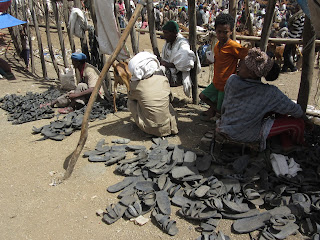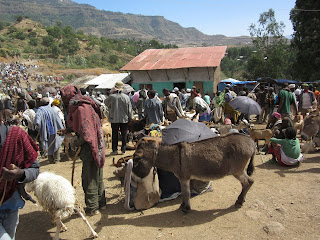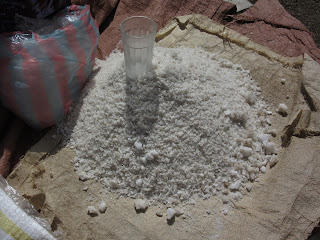After several days exploring Ethiopia's capital city of Addis Ababa, we got a morning flight to Lalibela, a town perched about 8,600 feet above sea level in the mountains northwest of Addis.
We had come to the small town of Lalibela because of its stunning cluster of 13 medieval rock-hewn churches and chapels that are often cited as an unofficial eighth wonder of the world. Our first hurdle was to get to Lalibela which didn't turn out to be as easy as planned!
I had my nose (and my camera!) glued to the window as I was so fascinated by the sights. I never expected to see the thatched roof huts as I naively thought those were present only in my images of Africa from half a century ago. Sometimes, the locals had simple stone houses but often there were only the huts. We have seen poverty all over the world but I was shocked anew by how desperately poor Ethiopia is.
The country is so poor that the only road connecting the airport to town was impassable for a good while until a grader came along and was able to break up the rocks on the gravel road.
That's Steven third from the right helping to push one of the other vans up the hill!
Hey - it's not every day you're standing around waiting for help up the hill and you see a man carrying a dead goat on a pole across his back!
At long last, the Chinese grader to the rescue! The Chinese, we later learned, were responsible for much of the road building going on in Ethiopia.
The long wait to get to the top of the mountain had been well worth it once we had this view before us.
We were still several miles out of town but we saw hundreds of locals who had hiked long distances to attend a religious celebration at a local church.
The residential part of Lalibela where the majority of locals lived was set a good piece away from the commercial part of the town.
We realized shortly that seeing men holding canes with their arms in this position was a common sight as they walked in the countryside regardless of whether they had animals in tow. In that case, the canes were a safety feature in case they came across a wayward animal!
After checking into our hotel, we went immediately to the town's Saturday Market and wandered around there for well over an hour. We couldn't believe how lucky we were that we just happened to arrive in Lalibela on the day of the weekly market as we hadn't known about it in advance
As you can see, this was not a genteel farmers' market in a cute American or Canadian suburb but a rough and tumble 'real' regional African market where people walk for days to sell their wares. It wasn't a market set up for tourists but for and by locals. That's what helped to make it so appealing to us.
A variety of spices for sale:
These sandals were made out of recycled tires. Boy, were they ever stinky!
There were a huge number of scales lined up but we didn't know why.
I wasn't at all familar with the various beans and grains for sale.
We learned later that many of the locals can only afford these very cheap plastic shoes and that they develop severe foot issues from wearing them.
I kept seeing piles of this white chunky substance but didn't know what it was either. I gave the woman selling it some small change because I wanted to taste it. Thank goodness I only tried a bit because it was salt! The woman laughed when she saw my expression after I tasted it.
Since we began traveling in earnest a few years ago, one of the items that has consistently drawn my attention has been scarves. Steven always says I have way too many as it is and I don't wear them enough and he is probably right. However, that hasn't stopped me from still wanting to look and occasionally even buying more! The one the woman has around her neck has the colors of Ethiopia's flag.
I have never come this close to a swarm of bees before but they certainly knew a good thing as the smidge of honey I tasted right out of the container was about the best you could get.
Hops used to make a local beer:
A special type of salt used to feed cattle:
Ginger for sale:
These two men, Hailu and Bekut, glommed onto us as we walked around the market wanting, they said, to practice their English with us. In the end of course, that was all a ruse as they wanted money even though we had told them from the outset that we didn't need them to walk with us and weren't going to be paying them. I still feel badly that we didn't 'tip' them and just hope that they got money from the next tourists they needed 'to practice their English on.'
There were untold piles of sorghum available for sale.
Bekut told me the coffee can was the measuring device used to sell the sorghum.
It was great seeing the US Agency for International Development coming to the assistance of the people in Lalibela.
Maize was being sold here.
Medium tef, one of the ingredients to make injera, the most popular Ethiopian dish.
Bekut said the scales were used to weigh lentils.
These were baby carriers made out of goat skin.
Another goat market but not as up close and personal like the one we had attended in Nizwa, Oman just recently!
Posted on December 10th, 2016 from Dubai, United Arab Emirates.
We had come to the small town of Lalibela because of its stunning cluster of 13 medieval rock-hewn churches and chapels that are often cited as an unofficial eighth wonder of the world. Our first hurdle was to get to Lalibela which didn't turn out to be as easy as planned!
We were so glad that we had made arrangements with our hotel to be picked up as there were no taxis on arrival at the tiny airport located about 40 minutes outside of town. This was the first airport we've been to where we collected our luggage on the tarmac too!
Scenes en route to Lalibela:I had my nose (and my camera!) glued to the window as I was so fascinated by the sights. I never expected to see the thatched roof huts as I naively thought those were present only in my images of Africa from half a century ago. Sometimes, the locals had simple stone houses but often there were only the huts. We have seen poverty all over the world but I was shocked anew by how desperately poor Ethiopia is.
The country is so poor that the only road connecting the airport to town was impassable for a good while until a grader came along and was able to break up the rocks on the gravel road.
That's Steven third from the right helping to push one of the other vans up the hill!
Hey - it's not every day you're standing around waiting for help up the hill and you see a man carrying a dead goat on a pole across his back!
At long last, the Chinese grader to the rescue! The Chinese, we later learned, were responsible for much of the road building going on in Ethiopia.
The long wait to get to the top of the mountain had been well worth it once we had this view before us.
We were still several miles out of town but we saw hundreds of locals who had hiked long distances to attend a religious celebration at a local church.
The residential part of Lalibela where the majority of locals lived was set a good piece away from the commercial part of the town.
We realized shortly that seeing men holding canes with their arms in this position was a common sight as they walked in the countryside regardless of whether they had animals in tow. In that case, the canes were a safety feature in case they came across a wayward animal!
After checking into our hotel, we went immediately to the town's Saturday Market and wandered around there for well over an hour. We couldn't believe how lucky we were that we just happened to arrive in Lalibela on the day of the weekly market as we hadn't known about it in advance
As you can see, this was not a genteel farmers' market in a cute American or Canadian suburb but a rough and tumble 'real' regional African market where people walk for days to sell their wares. It wasn't a market set up for tourists but for and by locals. That's what helped to make it so appealing to us.
A variety of spices for sale:
These sandals were made out of recycled tires. Boy, were they ever stinky!
There were a huge number of scales lined up but we didn't know why.
I wasn't at all familar with the various beans and grains for sale.
We learned later that many of the locals can only afford these very cheap plastic shoes and that they develop severe foot issues from wearing them.
I kept seeing piles of this white chunky substance but didn't know what it was either. I gave the woman selling it some small change because I wanted to taste it. Thank goodness I only tried a bit because it was salt! The woman laughed when she saw my expression after I tasted it.
Even though food was the primary focus of the regional market, a large section was devoted to selling clothes and household goods.
Many vendors had pails and buckets like these. I finally discovered they were selling honey as Lalibela is very famous for it.
I have never come this close to a swarm of bees before but they certainly knew a good thing as the smidge of honey I tasted right out of the container was about the best you could get.
Hops used to make a local beer:
A special type of salt used to feed cattle:
Ginger for sale:
These two men, Hailu and Bekut, glommed onto us as we walked around the market wanting, they said, to practice their English with us. In the end of course, that was all a ruse as they wanted money even though we had told them from the outset that we didn't need them to walk with us and weren't going to be paying them. I still feel badly that we didn't 'tip' them and just hope that they got money from the next tourists they needed 'to practice their English on.'
There were untold piles of sorghum available for sale.
Bekut told me the coffee can was the measuring device used to sell the sorghum.
It was great seeing the US Agency for International Development coming to the assistance of the people in Lalibela.
Medium tef, one of the ingredients to make injera, the most popular Ethiopian dish.
Bekut said the scales were used to weigh lentils.
These were baby carriers made out of goat skin.
Another goat market but not as up close and personal like the one we had attended in Nizwa, Oman just recently!
Traditional Ethiopian coffee pots:
It is experiences like being able to attend this market that make our trips so exciting for us. Being able to witness a culture and way of life so different from everything that is known and familiar to our lives back home is what keeps us on the road for long stretches of time. Posted on December 10th, 2016 from Dubai, United Arab Emirates.
























































































No comments:
Post a Comment
We love to hear from you!!!!